Please Take Note: This is a review of the game’s final prototype. The art, game bits, and the rules discussed are all subject to change. The game is being reviewed on the components and the rules provided with the understanding that “what you see is not what you might get” when the game is published. If you like what you read and want to learn more, we encourage you to visit the game’s web page or visit the Kickstarter project page to back it and get yourself a copy! Now that we have all that disclaimer junk out of the way, on with the review!
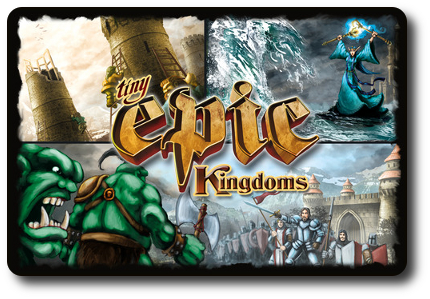
The Basics:
- For ages 9 and up (publisher suggests 13+)
- For 2 to 4 players
- Approximately 45 minutes to complete
Geek Skills:
- Active Listening & Communication
- Counting & Math
- Logical & Critical Decision Making
- Reading
- Pattern/Color Matching
- Strategy & Tactics
- Risk vs. Reward
- Hand/Resource Management
- Bluffing and Misdirection
- Worker Placement & Area Control
Learning Curve:
- Child – Easy
- Adult – Easy
Theme & Narrative:
- Lead your tiny kingdom to an epic win
Endorsements:
- Gamer Geek approved!
- Parent Geek approved!
- Child Geek approved!
Purchase:
Overview
Michel de Montaigne said “ambition is not a vice of little people”, nor is it for a tiny kingdom. Your lands are small, but you have big dreams. From your castle, you can see your territorial border and the lands beyond. They could be yours if you have the wit and the skill to claim them. Your people look to you to lead and inspire. Guide your subjects to a prosperous future and forge your kingdom into a mighty empire!
Tiny Epic Kingdoms, designed by Scott Almes and to be published by Gamelyn Games, will reportedly be comprised of 36 Faction cubes (9 each in 4 different colors), 4 Food cubes (yellow), 4 Ore cubes (red), 4 Magic cubes (green), 5 Action cubes (grey), 4 Faction cards, 4 Territory cards, 1 Tower Track card, 4 Player Town cards, and 1 Action Selection card. As this is a review of a prepublished game, I cannot comment on the game’s print and production quality. Nor can I suggest that the listed components are the only ones to be released in the final game.
Game Set Up
Note: The following game set up is for 3 to 4 players. The game set up steps are slightly different for a 2-player game which we have summarized in the Game Variant section of this review.
To set up Tiny Epic Kingdoms, first place the Tower Track and the Action Selection cards in the middle of the playing area.
Second, place the 5 Action cubes to the side of the Action Selection card and within easy reach of all the players.
Third, give each player 9 Faction cubes of a single color, 1 Food cube, 1 Ore cube, and 1 Magic cube. Any Faction, Food, Ore, and Magic cubes not used should be returned to the game box.
Fourth, either allow the players to select their Faction and Territory cards or randomly pass them out. Each Faction and Territory is unique, requiring different tactics and strategy. However, no one Faction or Territory has an advantage over the others. Selected Faction and Territory cards should be placed in front of the player. Any Faction and Territory cards not selected should be returned to the game box.
Fifth, give each player 1 Player Town card and have them place their Magic, Ore, and Food cubes on the numbered track that borders the Player Town card. Each number represent a number of resources. For example, if the Magic cube was placed on the “3”, the player would have 3 magic resources to spend. All players can place their Food, Ore, and Magic cubes on any of the numbered spaces on their Player Town card as long as the sum value of all 3 does not exceed “6”. It’s suggested that new or inexperienced players place their cubes so they have “1” ore, “2” magic, and “3” food. It’s possible to have zero of one or more resources. If such is the case, the corresponding cube should be placed to the side of the Player Town card.
Sixth, each player takes 2 Faction cubes and places 1 below the Tower Track card and 1 below their Faction card. From the remaining 7 Faction cubes, the players should take 2 and place them on any one area on their Territory card. A Territory is broken into different colored areas, where each color represents a specific resource that can be gathered. Faction cubes cannot be placed on the blue (water) areas.
This concludes game set up! Time to explore, expand, exploit, and exterminate! Determine who the first player will be and begin!
Pocket Conquest
Tiny Epic Kingdoms is played in turns, with no set number of turns per game. A single turn is summarized here.
Step 1: Clear Action Card
If the Action card has all 5 Action cubes on it, all the Action cubes are removed. This resets the Action card for the active player.
Step 2: Select an Action
The Action card lists 6 possible actions the active player can take on their turn. Note that I said “possible”. As the game progresses, the Action cubes are placed on the selected action which makes that specific action unavailable to the other players until the Action card is filled with all 5 Action cubes and cleared. A player may optionally decide to not place an Action cube on their turn.
A quick summary of the available actions follow:
- Patrol: Move 1 Faction cube within a Territory card
- Quest: Move 1 Faction cube to another Territory card
- Build: Advance the Faction cube to the next highest number value on the Tower card build track; the number value is the cost that must be paid for by spending ore
- Research: Advance the Faction cube to the next highest number on the Faction card magic mastery track; the number value is the cost that must be paid for by spending magic
- Expand: Add 1 Faction cube to the Territory card (no more than 2 Faction cubes can ever occupy the same area within a territory area)
- Trade: Trade any number of one resource to gain the same amount of a different resource (for example, trade 3 magic for 3 ore)
Step 3: Take Action or Collect Resources
The active player now takes their selected action (as summarized above).
If the active player elected to not place an Action cube, they can collect resources. The Territory cards have different areas (referred to as “spaces”) with a specific color. If the player has at least 1 Faction cube in a territory area, they advance the matching resource cube color to the next highest number value on the resource track found on their Player Town card. Only 1 resource is gathered per territory area regardless of how many Faction cubes the player has located on it.
- Yellow = (the farmlands and fields) +1 food
- Green = (the magical forests) +1 magic
- Red (the majestic mountains) = +1 ore
Step 4: Check for Endgame
All the players now check to see if the endgame has been triggered. The endgame is triggered when any of the following conditions exist after the active player has taken their action during step 3.
- At least 1 player has placed all 7 of their Faction cubes on the Territory cards
- At least 1 player has moved their Faction cube to the sixth position on the Tower card build track
- At lease 1 player has moved their Faction cube to the fifth position on their Faction card, mastering magic
If the endgame condition has not been met, the next player in turn order sequence now goes starting with step 1 noted above.
Tiny Epic Win
If the endgame has been triggered, play continues until all the Action cubes have been placed. This ends the game and the players now count up their points.
- +1 point for each Faction cube on any Territory card
- +1 point for each level of magic mastered, plus the additional bonuses obtained at the highest level of magic mastery
- Tower build points, which are based on the number of levels the player has built
Once the points have been added together, the player with the most points wins the game!
Factions Among Us
Each player will be leading a faction, which represents a specific race. For example, Elves, Humans, and Orcs. Each faction has their own special abilities that are only unlocked through research, which improves the faction’s level of magic mastery. When the faction’s understanding of magic improves, new abilities are unlocked. As each faction is different, it stands to reason that they have different strengths and weaknesses. This is visible on the Faction card. One faction might be better at war and improve their martial might through magical research, while another faction has a natural tendency towards exploration and trade. Dwarves, for example, improve their building abilities as the game progresses.
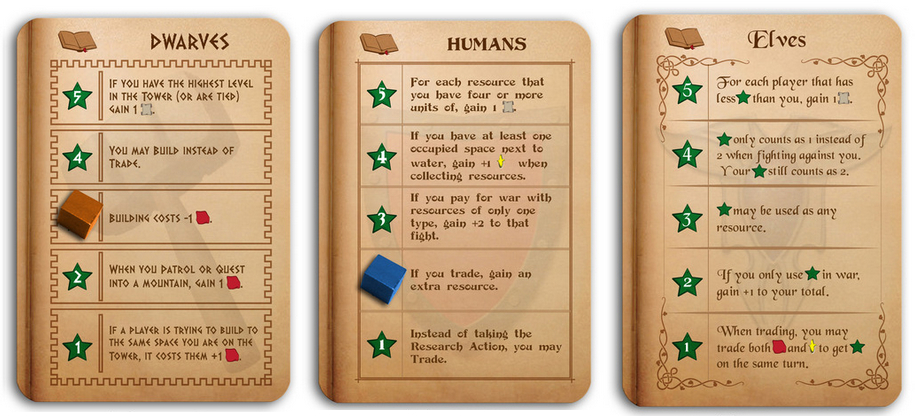
Patrolling, Expanding, and Questing
Within the player’s own territory, they can move their own Faction cubes to any 1 adjacent territory area. The only exception is the blue areas that represent water and cannot be moved into.
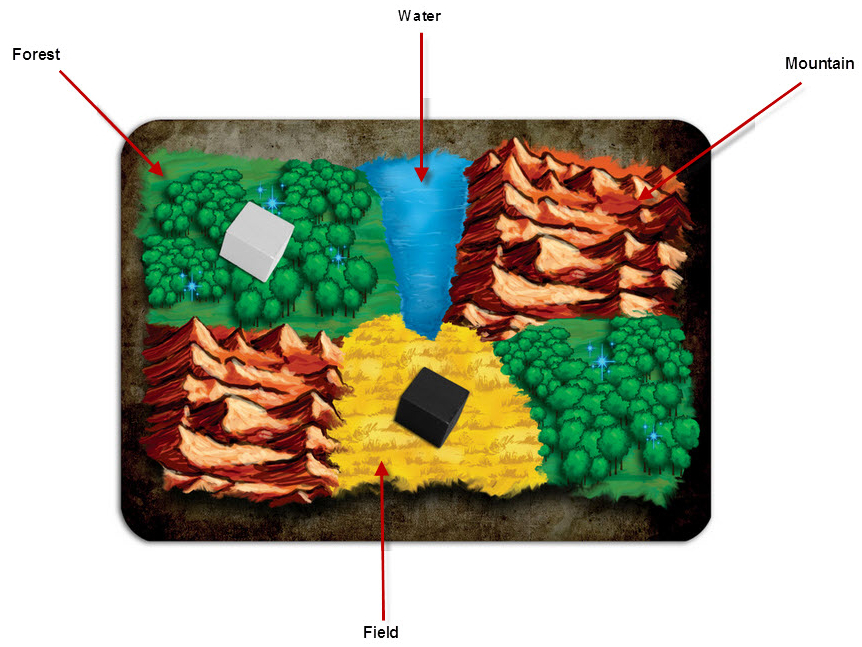
If the player’s Faction cube is located on a border territory area, they can elect to move their Faction cube to any other opponent’s border territory area. This is referred to as questing.
Of course, as the player’s faction travels and takes over new territory areas, the faction population can be expanded. This costs food and the player must be able to spend an equal number of food resources for every Faction cube they have in play at the time they add a new Faction cub to a territory. For example, the third Faction cube placed would cost 3 food and the sixth Faction cube place would cost 6 food.
Note that a territory area cannot contain any more than 2 Faction cubes at any time during the game. These Faction cubes can be the same or different colors.
Building Towers
Another option available to the players is to spend their energy building their kingdom. This is represented by the Tower card and the build track. As the players build, their own kingdom becomes larger. This will result in more points earned at the end of the game. Ore must be spent to build, but more can always be gathered from the mountains.
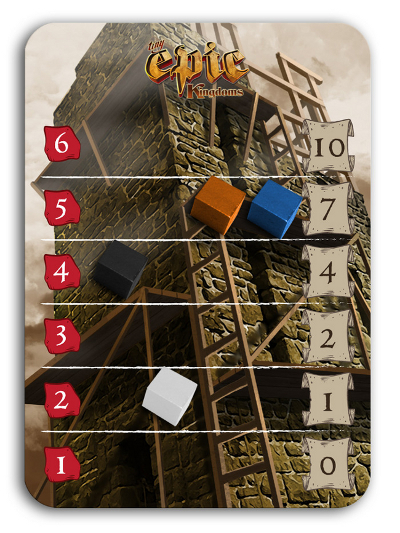
War and Peace
If a player moves their Faction cube into a territory area that is occupied by an opponent, both factions rally for war. Each player takes their Faction cube from the contested territory area and places it on a numbered space on their Player Town card. This should be done so their opponent does not see the value selected. The value represents how many resources the player is going to spend to feed and strengthen their army (maximum of 9). Only magic and ore are used during times of war. Magic is worth 2 resource points and ore is worth 1 resource point. Players must be able to pay the amount they select using these resources by reducing them on the resource track. When both players are done, they reveal their Faction cube placement and pay the resources. The player who paid the most wins the war and gets to keep the area. The loser takes their Faction cube off the area and returns it to their supply.

Or, the player could attempt to make peace and live in the same territory area with the other faction. In which case, the player simply keeps their Faction cube off their Town card. This is a gamble, however. If the player’s opponent opts to go to war, they will easily be kicked off the territory. But, if both players determine that peace is the best course of action, they get the benefit of being in an alliance. While in an alliance, all allied factions get to share the resources found in a shared territory area. If the player should ever attack a faction they are allies with, the truce is canceled and the outcome of the skirmish is determined as normal, but any Faction cubes in a shared territory area with the opponent must be removed.
War in Tiny Epic Kingdoms is as much about gambling as it is about bluffing. Players can clearly see the potential strength of their foe, but do not know how much effort they will put into winning a battle. A savvy player can drastically reduce an opponent’s resources if they can bluff them into thinking a massive battle is at hand! A player might lose a battle, but not the war as a result and weaken their foe for an easy victory. Additionally, losing ground might not be a terrible thing, especially if the player wants to pull back their Faction cubes quickly.
Game Variant
In a 2-player game, no alliances can be made. Only the strong will survive. In addition. a “lost kingdom” is introduced during game set up. This is a 3rd Territory card is placed in the middle of the playing area. Each area on the lost kingdom Territory card is populated with an unused Faction cube color. These territory areas must be won by fighting for them. At the end of the game, each player will receive +1 point for every territory area they occupy in the lost kingdom in addition to the other points they have earned.
To learn more about Tiny Epic Kingdoms, visit the game’s web page or visit the Kickstarter project page.
Prediction
Tiny Epic Kingdoms is a 4X game. If you have been reading Father Geek long, you should know by now that I have a love-hate relationship with 4X games in general. The endorsement levels often result in the Gamer Geeks loving them while everyone else is lost, bewildered, or terribly intimidated by them. This is because 4X games are big, difficult, and notoriously unforgiving. Luck never plays much of a role and a player must utilize skill, tactics, logical and critical thinking from the very start to the bitter end. An end, I might add, that might not come for hours.
For Gamer Geeks, this is the kind of game play they dream of. For the Parent and Child Geeks, this is the stuff of nightmares. I have seen 4X games make children cry and adults shake their head in dismaying bewilderment.
But Tiny Epic Kingdoms is different.
First of all, it’s small. Crazy small. To date, this is the smallest 4X game I have ever come across. Most of the time, 4X games come in big boxes and the weight can be measured in pounds. It’s also designed to be a microgame, which are noted for their quick game play and surprising level of game depth despite their size. In short, the game had me intrigued from the start, as its very existence defied commonly held gaming beliefs.
Teaching Tiny Epic Kingdoms is very straight forward. It’s best to teach the game while you’re playing it, as new players won’t really understand the actions if they cannot see the results of the actions on the game. For players familiar with 4X games, simply get the game out and get playing. The game play is very intuitive and the hardest part is determining which of the available actions you should take. Most of the time, I think you’ll find that the players make these choices fairly quickly as there is a great deal of information at the table and an opponent’s strength is always visible. Note that the game does require the players to be able to read, but it’s possible to play with younger players if teams are made. There is no hidden or secret information (except during times of war), which means other players can read for younger players without upsetting game play.
After teaching the game to my oldest little geek, I asked him his thoughts on Tiny Epic Kingdoms so far.
“Yeah! A 4X game that doesn’t take 4 days to play!” ~ Liam (age 9)
Yes, we are both very excited about the lack of time the game requires, but is the game too small to be enjoyed? Let’s play and find out if size does or doesn’t matter.
Final Word
The Child Geeks were very wary when I told them we would be playing a 4X game. Their last experience with such games did not end well. They believed that all 4X games were big, complex, and would take a long time to learn. When I put the small box in front of them, they were visibly surprised and relieved. After only one turn of game play, they were enjoying themselves and the game. According to one Child Geek, “This isn’t a 4X game! It only takes up a little of the table!” Another Child Geek said, “You should have played this game with us first because now I understand how to play games like this.” All the Child Geeks demonstrated smart game play, made tactical decisions, and explored different strategies. Tiny Epic Kingdoms was well-loved by the Child Geeks and they all voted to approve it.
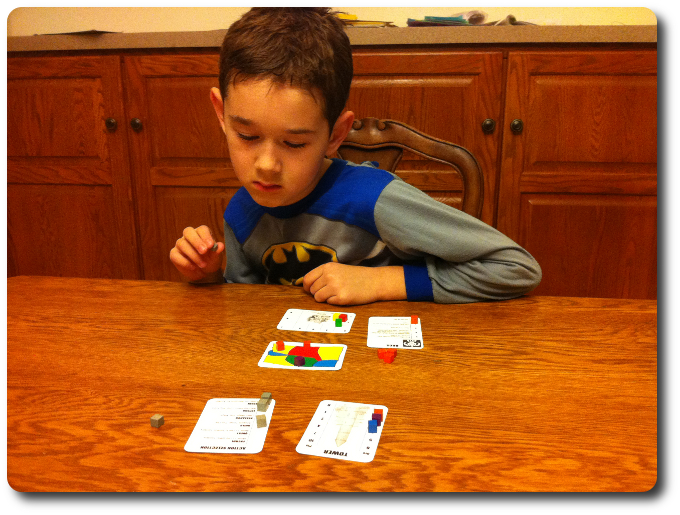
A 4X game before bedtime? UNHEARD OF!
The Parent Geeks were more skeptical than wary when I told them we would be playing a 4X game. Most of them told me they didn’t have the time or the table space to play the game. When I explained that all I needed was a small coffee table to play on and less than an hour of their time, they thought I was attempting to trick them. After I set up the game, explained the rules, and demonstrated a turn, they didn’t think Tiny Epic Kingdoms was a 4X game. When I asked them why, one of the Parent Geeks said, “It’s too small and too easy to learn.” Ha! I assured them that it was, indeed, a 4X game and we started playing. The first game took about an hour to play; the second only 30 minutes. After only 1 game, the Parent Geeks were playing like pros. Even the non-gamer Parent Geeks were doing well and enjoying themselves. According to one Parent Geek, “This game is doing everything right. It’s fast to set up, easy to learn, and fun to play!” Best of all, the Parent Geeks really enjoyed the fact that they could play Tiny Epic Kingdoms with their children without issue. The game proved to be not only fun with their peers, but with their families, winning the Parent Geeks’ approval as a result.
The Gamer Geeks jumped on Tiny Epic Kingdoms like hungry lions. According to one Gamer Geek, “Finally! A 4X game that we don’t need tables to play on.” Note the plural there. All the Gamer Geeks were surprised and delighted how much depth the microgame had. They were doubly pleased when they saw that strategic and tactical game play was there and necessary to win. One Gamer Geek explained, “This game might be small, but its design allows for the player to enjoy complex and intriguing game play.” Another Gamer Geek said, “This is a 4X game I’d play anytime, anywhere, and can!” The only negative I heard from the Gamer Geeks were comments regarding the game’s theme. Some Gamer Geeks wanted Tiny Epic Kingdoms to be set during World War II and some wanted to see the game in a science fiction setting. Regardless, all the Gamer Geeks voted to approve it.
Tiny Epic Kingdoms packs everything I love about 4x games into a small package that delivers big game play. Best of all, it takes only minutes to set up and less than an hour to complete. Despite its shorter game play time, none of the 4x game play or depth is lost. You get to explore, expand, exploit, and exterminate without rolling dice or leaving outcomes to chance. A player is always in control, but not always in the best position to get ahead. Warmongering and aggressive game play is not the only road to victory, and often times players will fail if they only invest their time focusing on just one aspect of the game.There are many roads to victory, but a player must travel a little on all of them to get the advantage. How they take that journey is up to them.
If you’re a fan of 4X games, than Tiny Epic Kingdoms is for you. If you like microgames that can be played in less than an hour, then Tiny Epic Kingdoms is for you. If you’re looking for a fun game you can play with your friends and family, then Tiny Epic Kingdoms is for you. If you like complexity, depth, strategy, and tactical game play, then Tiny Epic Kingdoms is for you. In fact, the only type of person Tiny Epic Kingdoms is not for are those individuals who don’t like to have fun!
This game was given to Father Geek as a review copy. Father Geek was not paid, bribed, wined, dined, or threatened in vain hopes of influencing this review. Such is the statuesque and legendary integrity of Father Geek.




Appreciate the review, Cyrus. I’ve followed this for a little while wondering whether to back or not and this seems like it could be a good game that works well with many groups. The fact that the non-gamers and kids had a good time makes it more likely that it will fit in well. The small size is also a bonus. Looks like I’ll probably want to add this to my “back” list. 🙂
My pleasure, Peter, and thanks for taking the time to leave a comment.
One word of caution: if you like the bulk of 4X games, Tiny Epic Kingdoms will disappoint you. It’s small, plays fast, is very well balanced, and has all the elements of a 4X game in a microgame. It will leave you wanting, however, if you like games that feel like a marathon.
I’ve played the game with my oldest before bedtime and during lunch breaks at the office. Not once did the games go over an hour and not once did I leave the table feeling like I played a “small game”.
I’m not too much into bulky/long games. The idea of a 4x game is interesting, but the time to play is not. 🙂 I’m curious about the “eXplore” portion, though. How does that really feature in something this small with so little area available? I get the explore part of computer 4x games, but I just don’t see it in this game unless I’ve really missed something.
“Traditional” 4X games provide random events and resources to be found during pawn movement while “eXploring”. This is not included in Tiny Epic Kingdoms to keep the game small and quick. Instead, each territory area provides a specific resource (magic, ore, or food) that can be harvested. Two players can share the same area for resources (referred to an alliance) or compete for it by doing battle. By far, the exploration aspect is the least “4X” aspect of the game, but I never felt like the game was missing anything. It felt like a 4X game to me from start to finish. Just a “different kind of” 4X game.
I guess one could say Tiny Epic Kingdoms is a 3.5X game. 🙂
Thank you for this review. I think I will be backing this and then doing a little review myself after receiving it. My family is not set up well for “Big” games with tons of depth, complexity and length so I don’t get to play any 4x type games. This sounds like a great alternative to the longer types of this game.
I’m just really happy you quoted Montaigne, because he’s my main man.
Pingback: Today in Board Games Issue #120 - Euphoria Winner! - Today in Board Games
Pingback: Tiny Epic Defenders Game Review - Father Geek